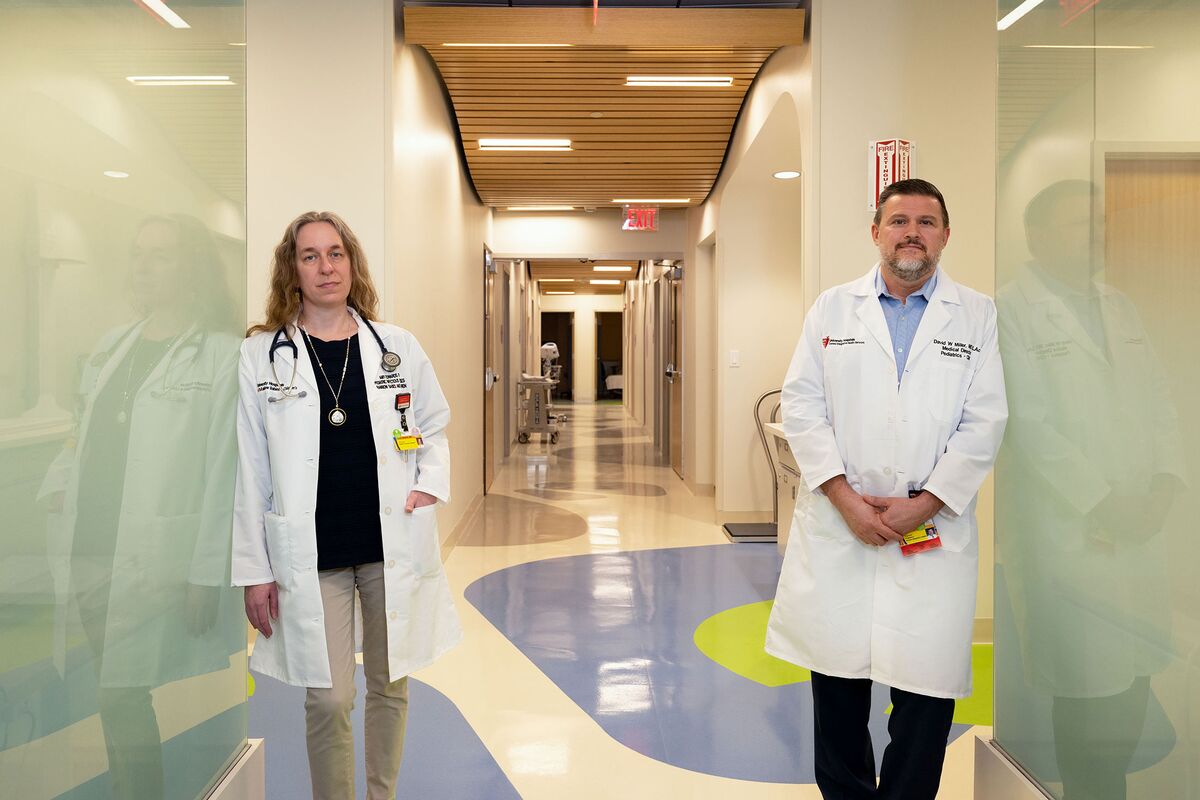The Children Left Behind by Long Covid
As the world pretends the pandemic is over, at least a half-million children in the U.S. are struggling with the mysterious disease.
By
Anna Edney
May 4, 2022, 5:00 AM EDT
Share this article
Lincoln Brockmeyer folds his lanky 6-foot-4-inch frame onto the examination table as he explains to the pair of doctors that he feels tapped out, his energy totally sapped. Some days, he says, he needs a nap to make it through the afternoon. Worse than the bone-tired feeling he can’t seem to shake is the constant pain in his legs and the sensation that each one weighs a thousand pounds. He tells the doctors that he’s lost weight—at one point he was down 30 pounds, to 148. He can’t run without getting lightheaded, he says, and every time he stands up he gets deep purple spidery veins on his arms and legs. He loves playing basketball, but not when his body hurts like this.
“I’m trying to stay optimistic,” he says when the doctors inform him he’s got all the signs of long Covid. They’re telling him this in March, and if he wants to get better he needs to take it easy. That means no basketball for a while. Lincoln hates hearing this. Still, they start hatching a plan—something none of the other doctors he’s seen have been able to offer. It’s too late for what would have been his freshman season of high school, but they’re hopeful he’ll be back on the court in time for his sophomore year. “We’ve got you,” says Amy Edwards, a pediatric infectious diseases expert who runs the long-haul Covid clinic at University Hospitals Rainbow Babies & Children’s hospital in Cleveland.

Edwards and Miller
Photographer: Daniel Lozada for Bloomberg Businessweek
The U.S. and the world are trying to move on from Covid-19. Everyone is tired of even thinking about it. The Centers for Disease Control and Prevention has effectively given up on trying to impose collective measures to control the virus. Even people who’ve been vigilant are ditching their masks. And, yet again, cases are rising in the U.S.
More cases will mean more long Covid, including pediatric long Covid. Estimates of the number of children who face long-term symptoms are far from precise, but they probably range from 5% to 10% of those infected with the virus, says Daniel Griffin, an infectious diseases expert at Columbia University who treats Covid patients and hosts a weekly podcast update on the disease. Even at the lower end of the estimates, that translates to more than a half-million children of the 13 million so far infected. (Studies of infected adults indicate that an estimated 10% to 30% may have long Covid.)
Up until last year, Lincoln, now 15, was a star forward on his middle school basketball team in Cuyahoga Falls, Ohio. So good, in fact, that high school coaches in the area were noticing his talent. In May, Lincoln’s parents moved the family to Copley, a small town west of Akron, so Lincoln could play on a team his parents believed would give him his best shot at success. “I’m going to brag on my kid a little bit,” says his father, Nate, who’s also sitting in the examination room. “He’s a stud basketball player.”
But when Lincoln was handing out Halloween candy last year, he felt cold symptoms coming on. He lay down and drifted into an uneasy sleep. His dad says Lincoln’s fever spiked to 104F and his breathing became labored. Lincoln tried pushing through his basketball tryouts the following week but couldn’t keep up. After missing a few days of school, he forced himself back. But when he noticed blood in his urine, his parents took him to the emergency room. Doctors ran tests over the course of a two-day hospital stay, including a Covid antibody test. The results showed only that Lincoln had had the illness at some point.
He filed through a round of appointments with specialists in oncology, pulmonology, and rheumatology, but none of the doctors could pinpoint a specific reason for his extreme fatigue. He stopped going to school again in November and was barely able to get out of bed until mid-January. One doctor put him on a powerful and potentially dangerous immunosuppressive drug called methotrexate that helped him regain enough energy to resume classes. Another urged his parents to take him to see pediatric long-Covid experts at Rainbow Babies & Children’s hospital. It took more than a month to get an appointment.
“Nobody knew what to do with him. It was very frustrating because I was like, ‘I don’t know what to do at this point. Nobody’s believing me’ ”
There isn’t much known about who gets long Covid or why, which puts it in a frustrating category of mysterious illnesses that occur after infections such as Lyme disease or mononucleosis. The National Institutes of Health is working on answering these questions about long Covid, but the findings won’t be available for at least another two years. And even that research will probably just scratch the surface of understanding. Meanwhile, many pediatricians still don’t take seriously the sometimes amorphous complaints of their young patients, perhaps suspecting they’re merely trying to avoid school. “They’re told, ‘It’s all in your head. You’re just depressed,’?” says David Miller, a pediatric integrative medicine specialist who sees long-Covid patients with Edwards at Rainbow Babies. “But now we have so many of them. Not all the kids are trying to get out of school.”
Even when doctors are attentive, children often can’t or don’t know how to articulate their symptoms. Fatigue is the most prevalent complaint, followed by pain. Difficulty paying attention and altered taste or smell are also common. Doctors who treat children and adolescents say their patients frequently show up with a battery of complaints affecting many different bodily systems, sometimes weeks after a Covid infection and regardless of the severity of the initial symptoms. At Rainbow Babies many children are surprised, as Lincoln was, to discover their stomach muscles hurt when slightly pressed, even when they’ve never noticed abdominal pain before. “The strange thing is how consistent it is,” Edwards says.

The lobby at Rainbow Babies.
Photographer: Daniel Lozada for Bloomberg Businessweek
Although children generally fare better with Covid than adults, many parents, lulled by flawed CDC guidance and a fire hose of online misinformation from self-appointed experts, have mistakenly assumed the virus poses no more risk to children than a common cold. Many pediatricians, too, have spent the pandemic unconvinced about the utility of testing sick kids for the virus. And only 28% of children age 5 to 11 had been given two doses of a Covid vaccine as of late April, according to the CDC. These factors help explain why pediatric hospitalizations reached a pandemic peak during omicron. Deaths are rare, but that’s scant comfort to the parents of the 1,010 children with Covid who have died in the U.S. And even though that number is far surpassed by adult lives lost, Covid was still the fourth-leading cause of death in kids in January, according to the Kaiser Family Foundation and the Peterson Center on Healthcare.
Not every kid with long Covid has it as severely as Lincoln; some have it much worse. Griffin recalls meeting with a 16-year-old girl who couldn’t sit up for more than a few minutes without throwing up, so her mother took her to a pediatric long-Covid clinic in Colorado. Griffin says the last time he talked with the girl, she could sit up for about 45 minutes without vomiting.
Children suffering from long Covid who are able to get in to see Edwards, Miller, or other doctors at the roughly 75 to 100 children’s hospitals that have set up long-Covid clinics across the country are the lucky ones. These doctors tend to take on the role of support coaches, helping children organize their days and scheduling frequent breaks so they can care for themselves better. They may advise changing diets to cut out white sugar in favor of eating anti-inflammatory fruits and vegetables. Or they may schedule an appointment with a cardiologist, gastroenterologist, or physical therapist.
Some doctors contend that whatever these kids are suffering from, it isn’t long Covid. One outspoken skeptic of long-Covid treatment is Kristen Walsh, a pediatrician in New Jersey who’s convinced doctors are financially motivated to treat a made-up condition. “There’s been a lot of money earmarked for Covid in kids and hospitals to open these clinics,” Walsh says. “Follow the money.” But, like so much heated debate over the pandemic, Walsh’s argument is infused with more emotion than factual accuracy: The NIH has awarded large amounts of money for research on long Covid, but that money doesn’t extend to treatment clinics. Walsh is a founding member of a group that calls itself Urgency of Normal, composed of about a dozen doctors who earlier this year began a noisy campaign to drop pandemic restrictions, particularly masking in schools. They also provide a “toolkit” for parents that minimizes the risks for children. These doctors insist, for instance, that Covid is like the flu for unvaccinated kids and that long Covid is not a major risk.
“It makes me so mad,” says Alexandra Yonts, an infectious diseases physician who runs a pediatric long-Covid clinic at Children’s National Hospital in Washington, D.C. “There have been so many things discounted because kids don’t have a voice.” Children’s National received $40 million from the NIH last year to study the long-term effects of Covid, but the funding is only for research, not the pediatric long-Covid clinic, Yonts says. She spends her off-hours wrangling specialists to meet with patients. She says she was skeptical about post-infection illnesses prior to Covid, but the influx of patients with lingering symptoms coming into the hospital opened her eyes.
Determined parents eventually find their way to Children’s National or one of the other pediatric long-Covid clinics in the U.S. They’re staffed with doctors who, like Yonts, work extra hours to squeeze in long-Covid patients around their regular caseload. That’s increasingly tough to do, because more and more children keep pouring in. Following omicron the number of families seeking help at the long-Covid clinic at Children’s National has swelled. Yonts says the waitlist has stretched to four months. The story is similar across the country. “Post-infection syndromes used to be one here, one there. They weren’t so common,” says Sindhu Mohandas, a pediatric infectious disease specialist who leads the long-Covid clinic at Children’s Hospital Los Angeles. “But now we’re seeing a lot more.” She says her clinic is getting calls from all over the country.
Many children slip through the cracks, though, especially those from Black and Hispanic families. At Children’s National, the clinic primarily sees “affluent, medically literate, White families,” Yonts says, even though Black and Hispanic people in Washington are more likely to have had Covid than Whites. A report out at the end of March, The State of Black America and Covid-19, said there is “already evidence of disparities in diagnosis and access to treatment” regarding long Covid. The group that released the report, the Black Coalition Against Covid, says more efforts are needed to include Black people in trials and treatment programs.

The playground at Rainbow Babies.
Photographer: Daniel Lozada for Bloomberg Businessweek
The Rainbow Babies clinic operates much the same way as Children’s National. Edwards was introduced to long Covid through her work on a different Covid-related condition called multisystem inflammatory syndrome in children, or MIS-C. When a nearby medical center wanted to open an adult long-Covid clinic, it sought out Edwards and asked if she could handle any kids who also came in. It wouldn’t be many, she recalls them saying. “I was like, ‘Sure, one or two kids here or there? I can do it.’?”
What started out as a trickle grew into a torrent. Edwards ran into Miller in the hallway one day and asked for his help. They still have more patients than they can handle, especially because they have to squeeze in the 60 cases or so that they’ve seen in the last year around their regular practices. The children they treat usually have ailments complex enough that appointments often take much longer than an hour—compared with standard office visits of 15 to 30 minutes—and they have to return for multiple follow-up visits. It takes about six weeks for a new patient to get an appointment.
At Rainbow Babies, Edwards and Miller see their long-Covid patients every Friday. “I’m sure we’re losing money for the hospital system, because we’re only seeing five patients in a day,” Edwards says.
She’s talking in between seeing patients in a room normally used for psychologists to observe children through a two-way mirror. It’s subdued compared with the bright, happy forest landscapes that cover the walls and ceilings throughout the lobby and hallways of Rainbow Babies. Edwards and Miller see their patients wherever they can find an open spot in a wing of the hospital for specialty care. Edwards does all the administrative work herself. Her own kids know she won’t be home in time for dinner most Fridays.
In early March, Edwards and Miller see their youngest patient. Hunter Reinard, who’s just turned 4, has been sick with long Covid for two of those years. He hides behind a blue chair in the exam room, while his mother, Kristin, explains that after the entire family came down with Covid early in the pandemic, he began suffering from high fevers every few weeks. He wasn’t eating well (he told his mom food smelled “disgusting”) and wasn’t sleeping. Over a course of months, Kristin had taken Hunter to a series of hospitals—including the Cleveland Clinic and, before the long-Covid clinic opened, Rainbow Babies. “Nobody knew what to do with him,” Kristin says to Edwards and Miller. “It was very frustrating because I was like, ‘I don’t know what to do at this point. Nobody’s believing me.’?”
She tells the doctors that Hunter is beginning to gain weight thanks to the PediaSure shakes she’s been giving him. She and her husband also stopped finding Hunter downstairs at 4 in the morning playing with his toys, once they started giving him a melatonin supplement to help him sleep.
But the family all got Covid again in December. In February, Hunter’s on-and-off-again fever hit 106F. He began hallucinating, seeing characters from his favorite video games floating on the ceiling. Kristin says she’s been feeling overwhelmed.
“I want to say, ‘You’re not crazy,’?” Edwards says to her.
“I feel crazy,” Kristin says. “For a year and a half nobody believed me.”
“I believe you,” Edwards says.
Some in the medical community theorize that long Covid is an autoimmune response or that the virus causes nerve damage. But no one knows for sure. At Rainbow Babies, Edwards and Miller tend to prescribe rest and diet changes. Lincoln Brockmeyer says the support and guidance he’s gotten from his doctors have begun to pay off. He’s eating better and is almost back to his pre-Covid weight. He has more energy, too. Getting refined sugar out of his diet has been a “game changer,” he says. He can take longer walks now, and on good days he can’t resist shooting a few hoops. But he has to sit down between shots. “That was the thing that was most disappointing, because I missed my whole basketball season,” he says. “I worked so hard, and it all got thrown away.”
Basketball hasn’t been the only loss for this high school freshman in a brand-new town. Lincoln says he’d just started warming up to people at his school when he got sick. Then he was left to watch on Snapchat all the fun his new friends were having. “I felt really alone,” he says.
He still feels behind in school but says his mental health has improved since the diagnosis. “Now that I feel like we know it is long haul, it feels better to know what I actually have,” he says, “and that we’re able to do something about it.”
@annaedney
+ Get alerts forAnna Edney
In this article
SB1
Generic 1st 'SB' Future
18.63
USd/lb.
+0.01+0.05%
Have a confidential tip for our reporters?
Get in touch
Before it's here, it's on the
Bloomberg Terminal
Up Next
'Bridgerton' Gets Its Own Live Immersive Experience

A trio of attendees at “The Queen’s Ball: A ‘Bridgerton’ Experience.” Photographer: Federico Imperiale/Fever
CityLab
Culture
After Immersive Van Gogh, It’s Time for Live-Cosplay ‘Bridgerton’
An interactive show dedicated to the Netflix costume drama joins the growing crop of experience rooms occupying urban spaces left vacant by the pandemic.
By
Kriston Capps
April 30, 2022, 1:35 PM EDT
Terms of Service Do Not Sell My Info (California) Trademarks Privacy Policy ©2022 Bloomberg L.P. All Rights Reserved |




